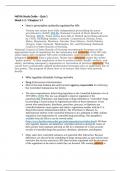N676A Study Guide – Quiz 1
Week 1-2 / Chapters 1-7
How is prescriptive authority regulated for NPs
Twenty-one states have fully independent prescribing by nurse
practitioners (AANP, 2013b; National Council of State Boards of
Nursing, 2015). Some states have full or limited prescribing allowed
by CNSs, including Alaska, Colorado, Connecticut, Hawaii, Iowa,
Idaho, Minnesota, Montana, Nevada, New Mexico, North Dakota,
Oregon, Utah, Vermont, Washington, DC, and Wyoming (National
Council of State Boards of Nursing,
National Council of State Boards of Nursing recommends licensure as the
appropriate level of regulation for the autonomy and authority of the NP role,
some states still recognize NPs with certification, endorsement, or through
delegated authority from a physician. States have authority under the states’
“police power” to take regulatory action to protect public health, welfare, and
safety, including emergency suspension or revocation of practice authority. The
courts have consistently upheld professional licensing laws as legitimate use of
this power. The purpose of these laws is to ensure that those who provide
health-
Who regulates Schedule II drugs and why
Drug Enforcement Administration
DEA is the lead Federal law enforcement agency responsible for enforcing
the Controlled Substances Act (CSA).
The most comprehensive federal drug legislation is the Controlled Substances Act of
1970 (FDA, 2010). This law was designed to improve regulation of the
manufacturing, distribution, and dispensing of drugs identified as “controlled” drugs
by providing a closed system for legitimate providers of these substances. Every
person who manufactures, distributes, prescribes, procures, or dispenses any
controlled substance must register and obtain a registration number with the U.S.
Drug Enforcement Administration (DEA). The Practitioner's Manual: An
Informational Outline of the Controlled Substances Act, published in 2006, outlines
regulations and requirements for controlled-drug prescribing. This pamphlet is
available from the DEA or can be viewed online
(http://www.deadiversion.usdoj.gov/pubs/manuals/pract/index.html). All those
who regularly dispense and administer controlled substances during the course of
their practice must maintain and keep on file for a minimum of 2 years accurate
records of controlled drugs they purchase, distribute, administer, and dispense.
Many states have controlled substance acts patterned after federal law. Because
differences are allowed in the scheduling of drugs among states (a state may be more
restrictive but not less restrictive), NPs must become acquainted with the provisions
of the regulations in the state in which they are licensed. NPs wanting authority to
, prescribe controlled substances must apply for state prescriptive authority prior to
application for a federal DEA number. Applications for a DEA number may be
obtained online through the DEA or though the state regional office. Before applying,
it is important to verify with the state board of nursing or pharmacy if a state-issued
prescribing number or certificate is also issued separately from the NP license.
For many years the DEA number was inappropriately used for other than controlled
substances by pharmacies, primarily to bill insurance or track medications under a
provider-unique identifier. Concern over this as well as the plethora of separate
numbers used for Medicaid and Medicare billing led to the development and use of
the National Provider Identifier number (NPI). The NP should obtain an NPI as soon
as it is feasible. Application is free and available online. This number is unique to the
provider and is used for all prescriptions that are billed through insurance, as well as
for other billing services.
In an effort to control drug distribution, a classification system was developed to
categorize drugs as “controlled” based on their potential for abuse, accepted medical
use, and diversion potential. NPs must know the different classifications and
schedules of controlled drugs as well as the associated prescribing rules and
regulations. Controlled drugs are listed in five different schedules— I, II, III, IV, and
V—to which different regulations apply. Controlled substance authority for NPs
varies from state to state according to ability and autonomy of practice.
Table 4-1 presents the schedules, controls required, and examples of drugs.
Controlled Substance Prescribing Precautions
Prescribers should take precautions with controlled drug prescription pads and
information included on the controlled substance prescription to minimize the chance
for fraud and diversion of these drugs. The prescription pad (or prescription printer
paper) should be stored in a locked area or locked drawer on the printer. Prescriptions
should never be signed in advance or used as notepads. The prescriber's name, NPI
number, address, and telephone number should be printed on the pads to allow
verification by the dispensing pharmacist. Some states also require that the NP's
license number appear on the prescription in addition to that of any
supervising/collaborating practitioner. The DEA registration number must be
designated on all controlled substance prescriptions, though individual states may
permit a pharmacist to write in the DEA number if it is not initially provided. The
prescription should be dated on the day it is written, indicating any authorized refills
as allowed and clinically appropriate. It is helpful to spell out the quantity dispensed
as well, using an Arabic numeral (e.g., “forty [40]”) to discourage alterations in the
intended quantity.
A prescription for a controlled substance may be directly faxed to the pharmacy as an
additional precaution, with the exception of Schedule II controlled substances. A fax
cannot be considered the original for Schedule II drugs unless the drug in question is




